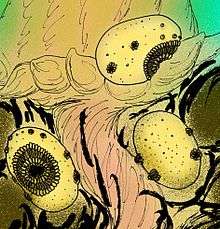Saccorhytus
Saccorhytus (from Latin saccus "bag" and Ancient Greek ῥύτις rhytis "wrinkle") is an extinct genus of animal belonging to the superphylum Deuterostomia, which is represented by a single species, Saccorhytus coronarius (from Latin attributive coronarius "[of a] crown"). Having lived approximately 540 million years ago in the Fortunian stage of the Cambrian Period, it is the oldest known confirmed species of this superphylum.[1][2]
| Saccorhytus | |
|---|---|
 | |
| Artist's reconstruction of Saccorhytus coronarius | |
| Scientific classification | |
| Kingdom: | Animalia |
| Superphylum: | Deuterostomia |
| (unranked): | †Saccorhytida Han et al., 2017 |
| Family: | †Saccorhytidae Han et al., 2017 |
| Genus: | †Saccorhytus Han et al., 2017 |
| Species: | †S. coronarius |
| Binomial name | |
| †Saccorhytus coronarius Han et al., 2017 | |
Fossils of the species were first discovered in the Kuanchuanpu Formation of Shaanxi province of China by a team of scientists from the United Kingdom, China and Germany,[1] and the findings were first published in January 2017.[3][4]
Description
Saccorhytus was only about a millimetre (1.3 mm[3][5]) in size and is characterised by its globular or hemispherical body with a prominent mouth.[6] Its body was covered by a thick but flexible cuticle. It had four nodulate rugae above its mouth. Around its body are eight openings in the form of truncated cones with radial folds, termed "body cones." Two sets of small circular pores also occur on the body; one set is widely separated and runs parallel to the body cones, while the other set is more dorsal and consists of sub-linear arrays. The latter set of pores may have housed setae, which may have played a haptic role, including temporary attachment, while the former set may have had a sensory function, though they could have alternatively released internal contents like adhesive mucus or gametes. In the mid-region of its body, spines protrude anteriorly.[3]
There is no evident anus,[3] which means that the animal must have consumed its food and excreted it from the same orifice,[1] though the body cones may have served this function as well in addition to expelling water.[3] However, the strong folding found in the fossils makes this conclusion tentative,[3] with Simon Conway Morris, one of the British scientists involved in its discovery, admitting the possibility that the team simply has not spotted it.[7]
Phylogeny
Saccorhytus is classified as a deuterostome due to its possession of body openings in the form of its body cones, which appear similar to apparently equivalent structures in vetulicolians and vetulocystids, and thus was thought to be closely related to those two clades by Han et al.[3] Below is a simplified phylogenetic tree based on that constructed by Han et al.[3]
| ||||||||||||||||||||||||||||
Since the earliest deuterostomes had a one-way through gut, the evident lack of an anus may either be a secondary loss (as seen in ophiurioids) or a plesiomorphic trait inherited from more primitive bilaterian ancestors, which may be linked to acoels and xenoturbellids.[3]
Palaeoecology
Saccorhytus most likely lived a meiofaunal lifestyle, with its body plan suited for an interstitial habitat, such as its thick but flexible cuticle providing protection and allowing it to wriggle through grains of sand, and the dorsal set of circular pores could have allowed it to attach itself to them.[3][7] While feeding, the large quantities of water it would swallow would then be expelled through its body cones.[7]
References
- Ghosh, Pallab (30 January 2017). "Scientists find 'oldest human ancestor'". BBC. Retrieved 30 January 2017.
- "Bag-like sea creature was humans' oldest known ancestor". Phys.org. 30 January 2017. Retrieved 30 January 2017.
- Han, Jian; Morris, Simon Conway; Ou, Qiang; Shu, Degan; Huang, Hai (2017). "Meiofaunal deuterostomes from the basal Cambrian of Shaanxi (China)". Nature. 542 (7640): 228–231. doi:10.1038/nature21072. ISSN 0028-0836. PMID 28135722.
- Wade, Nicholas (30 January 2017). "This Prehistoric Human Ancestor Was All Mouth". New York Times. Retrieved 31 January 2017.
- Khan, Amina (31 January 2017). "Humans, meet the ancient sea creature at the other end of your family tree". Los Angeles Times. Retrieved 1 February 2017.
- Lindermann, Katherine (30 January 2017). "Meet your earliest known ancestor: Saccorhytus". ResearchGate (Interview). Retrieved 30 January 2017.
- Davis, Nicola (30 January 2017). "A huge mouth and no anus – this could be our earliest known ancestor". The Guardian. Retrieved 2 February 2017.